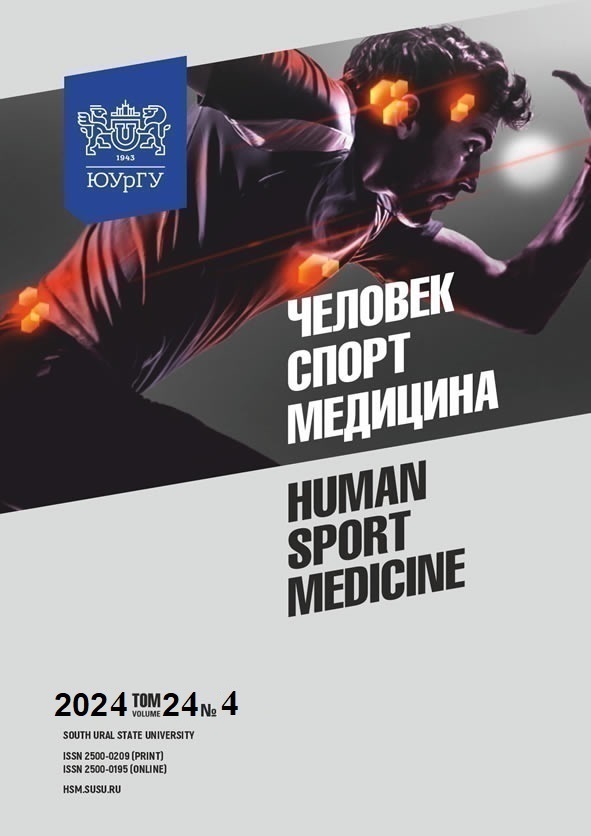ОЦЕНКА СИЛЫ МЫШЦ СГИБАТЕЛЕЙ И РАЗГИБАТЕЛЕЙ ТУЛОВИЩА В ИЗОКИНЕТИЧЕСКОМ РЕЖИМЕ
Аннотация
Цель: обозначить подходы к измерению силовых возможностей мышц сгибателей и разгибателей туловища в изокинетическом режиме мышечного сокращения. Материалы и методы. Проведена изокинетическая оценка силы мышц сгибателей и разгибателей туловища на изокинетическом динамометре IsoMed 2000 молодых футболистов 13–17 лет, а также представлено методическое описание оценки силовых возможностей мышц СРТ. Результаты. Исследование показало статистически значимый рост относительной силы мышц сгибателей (p < 0,001, R2 = 0,137) и разгибателей (p < 0,001, R2 = 0,254) туловища с увеличением возраста участников, отношение силы мышц сгибателей к разгибателям туловища с возрастом не изменяется. Заключение. Результаты исследования позволяют начать формирование выборки для создания референсных значений силовых параметров мышц туловища для молодых футболистов 13–17 лет и по значению отношения сгибатели – разгибатели, которые в дальнейшем могут помочь определить дефицит мышечной силы у молодых футболистов и обосновать подходы к профилактике спортивных травм.
Литература
2. Araujo S., Cohen D., Hayes L. Six Weeks of Core Stability Training Improves Landing Kinetics Among Female Capoeira Athletes: A Pilot Study. Journal of Human Kinetics, 2015, vol. 45, no. 1, pp. 27–37. DOI: 10.1515/hukin-2015-0004
3. Babayeva N., Torğutalp Ş.Ş., Dönmez G. Spondylolysis in an Adolescent Soccer Player. Austin Sports Medicine, 2017, vol. 2 (1), 1013.
4. Barbado D., Lopez-Valenciano A., Juan-Recio C. et al. Trunk Stability, Trunk Strength and Sport Performance Level in Judo. PLOS ONE, 2016, vol. 11, no. 5, e0156267. DOI: 10.1371/journal. pone.0156267
5. Baur H., Müller S., Pilz F. et al. Trunk Extensor and Flexor Strength of Long-distance Race Car Drivers and Physically Active Controls. Journal of Sports Sciences, 2010, vol. 28, no. 11, pp. 1183–1187. DOI: 10.1080/02640414.2010.484066
6. Chang W.-D., Lin H.-Y., Lai P.-T. Core Strength Training for Patients with Chronic Low Back Pain. Journal of Physical Therapy Science, 2015, vol. 27, no. 3, pp. 619–622. DOI: 10.1589/jpts.27.619
7. Cho K.H., Beom J.W., Lee T.S. et al. Trunk Muscles Strength as a Risk Factor for Nonspecific Low Back Pain: A Pilot Study. Annals of Rehabilitation Medicine, 2014, vol. 38, no. 2, p. 234. DOI: 10.5535/arm.2014.38.2.234
8. Cronström A., Creaby M.W., Nae J. et al. Modifiable Factors Associated with Knee Abduction During Weight-Bearing Activities: A Systematic Review and Meta-Analysis. Sports Medicine, 2016, vol. 46, no. 11, pp. 1647–1662. DOI: 10.1007/s40279-016-0519-8
9. Czaprowski D., Kolwicz A., Afeltowicz A. et al. Reliability of Measurements of the Exten-sion-flexion Ratio with Surface EMG. Journal of Back and Musculoskeletal Rehabilitation, 2015, vol. 28, no. 4, pp. 827–832. DOI: 10.3233/bmr-150590
10. Danneskiold-Samsøe B., Bartels E.M., Bülow P.M. et al. Isokinetic and Isometric Muscle Strength in a Healthy Population with Special Reference to Age and Gender. Acta Physiologica (Oxford, England), 197, suppl. 673, pp. 1–68. DOI: 10.1111/j.1748-1716.2009.02022.x
11. De Blaiser C., Roosen P., Willems T. et al. Is Core Stability a Risk Factor for Lower Extremity Injuries in an Athletic Population? A Systematic Review. Physical Therapy in Sport, 2018, vol. 30, pp. 48–56. DOI: 10.1016/j.ptsp.2017.08.076
12. Estrázulas J.A., Estrázulas J.A., de Jesus K. et al. Evaluation Isometric and Isokinetic of Trunk Flexor and Extensor Muscles with Isokinetic Dynamometer: A Systematic Review. Physical Therapy in Sport, 2020, vol. 45, pp. 93–102. DOI: 10.1016/j.ptsp.2020.06.008
13. Grabiner M.D., Jeziorowski J.J. Isokinetic Trunk Extension and Flexion Strength-endurance Relationships. Clinical Biomechanics (Bristol, Avon), 1991, vol. 6 (2), pp. 118–122. DOI: 10.1016/0268-0033(91)90009-F
14. Guilhem G., Giroux C., Couturier A. et al. Validity of Trunk Extensor and Flexor Torque Measurements Using Isokinetic Dynamometry. Journal of Electromyography and Kinesiology, 2014, vol. 24, no. 6, pp. 986–993. DOI: 10.1016/j.jelekin.2014.07.006
15. Harding A.T., Weeks B.K., Horan S.A. et al. Validity and Test–retest Reliability of a Novel Simple Back Extensor Muscle Strength Test. SAGE Open Medicine, 2017, vol. 5, 205031211668884. DOI: 10.1177/2050312116688842
16. Lim E.C.W., Poh R.L.C., Low A.Y. et al. Effects of Pilates-Based Exercises on Pain and Disability in Individuals With Persistent Nonspecific Low Back Pain: A Systematic Review With Meta-analysis. Journal of Orthopaedic & Sports Physical Therapy, 2011, vol. 41, no. 2, pp. 70–80. DOI: 10.2519/jospt.2011.3393
17. McGregor A., Hill A., Grewar J. Trunk Strength Patterns in Elite Rowers. Isokinetics and Exercise Science, 2004, vol. 12, no. 4, pp. 253–261. DOI: 10.3233/IES-2004-0183
18. Mueller J., Mueller S., Stoll J. et al. Trunk Extensor and Flexor Strength Capacity in Healthy Young Elite Athletes Aged 11–15 Years. Journal of Strength and Conditioning Research, 2014, vol. 28, no. 5, pp. 1328–1334. DOI: 10.1519/jsc.0000000000000280
19. Mueller S., Mayer P., Baur H. et al. Higher Velocities in Isokinetic Dynamometry: A Pilot Study of New Test Mode with Active Compensation of Inertia. Isokinetics and Exercise Science, 2011, vol. 19, no. 2, pp. 63–70. DOI: 10.3233/IES-2011-0398
20. Mueller S., Stoll J., Cassel M. et al. Trunk Peak Torque, Muscle Activation Pattern and Sudden Loading Compensation in Adolescent Athletes with Back Pain. Journal of Back and Musculoskeletal Rehabilitation, 2019, vol. 32, no. 3, pp. 379–388. DOI: 10.3233/bmr-181215
21. Mueller S., Stoll J., Mueller J. et al. Validity of Isokinetic Trunk Measurements with Respect to Healthy Adults, Athletes and Low Back Pain Patients. Isokinetics and Exercise Science, 2012, vol. 20, no. 4, pp. 255–266. DOI: 10.3233/IES-2012-00482
22. Prieske O., Muehlbauer T., Granacher U. The Role of Trunk Muscle Strength for Physical Fitness and Athletic Performance in Trained Individuals: A Systematic Review and Meta-Analysis. Sports Medicine, 2016, vol. 46, no. 3, pp. 401–419. DOI: 10.1007/s40279-015-0426-4
23. Rossi D.M., Morcelli M.H., Cardozo A.C. et al. Rate of Force Development and Muscle Activation of Trunk Muscles in Women with and without Low Back Pain: A Case-control Study. Physical Therapy in Sport, 2017, vol. 26, pp. 41–48. DOI: 10.1016/j.ptsp.2016.12.007
24. Roth R., Donath L., Kurz E. et al. Absolute and Relative Reliability of Isokinetic and Isometric Trunk Strength Testing Using the IsoMed-2000 Dynamometer. Physical Therapy in Sport, 2017, vol. 24, pp. 26–31. DOI: 10.1016/j.ptsp.2016.11.005
25. Shah T., Cloke D.J., Rushton S. et al. Lower Back Symptoms in Adolescent Soccer Players: Predictors of Functional Recovery. Orthopaedic Journal of Sports Medicine, 2014, vol. 2, no. 4, 232596711452970. DOI: 10.1177/2325967114529703
26. Sihvonen T., Partanen J., Hänninen O. et al. Electric behavior of Low Back Muscles During Lumbar Pelvic Rhythm in Low Back Pain Patients and Healthy Controls. Archives of Physical Medicine and Rehabilitation, 1991, vol. 72, no. 13, pp. 1080–1087.
27. Sinaki M., Limburg P.J., Wollan P.C. et al. Correlation of Trunk Muscle Strength with Age in Children 5 to 18 Years Old. Mayo Clinic Proceedings, 1996, vol. 71, no. 11, pp. 1047–1054. DOI: 10.4065/71.11.1047
28. Victora R.C., Vieira A. Do Muscle Strength Imbalances and Low Flexibility Levels Lead to Low Back Pain? A Brief Review. Journal of Functional Morphology and Kinesiology, 2017, vol. 2, no. 3, p. 29. DOI: 10.3390/jfmk2030029
29. Wall J., Meehan W.P., Trompeter K. et al. Incidence, Prevalence and Risk Factors for Low Back Pain in Adolescent Athletes: a Systematic Review and Meta-analysis. British Journal of Sports Medicine, 2022, vol. 56, no. 22, pp. 1299–1306. DOI: 10.1136/bjsports-2021-104749
30. Zouita Ben Moussa A., Zouita S., Ben Salah F. et al. Isokinetic Trunk Strength, Validity, Reliability, Normative Data and Relation to Physical Performance and Low Back Pain: a Review of the Literature. International Journal of Sports Physical Therapy, 2020, vol. 15, no. 1, pp. 160–174.
References
1. Akebi T., Saeki S., Hieda H. et al. Factors Affecting the Variability of the Torque Curves at Isokinetic Trunk Strength Testing. Archives of Physical Medicine and Rehabilitation, 1998, vol. 79, no. 1, pp. 33–35. DOI: 10.1016/s0003-9993(98)90204-02. Araujo S., Cohen D., Hayes L. Six Weeks of Core Stability Training Improves Landing Kinetics Among Female Capoeira Athletes: A Pilot Study. Journal of Human Kinetics, 2015, vol. 45, no. 1, pp. 27–37. DOI: 10.1515/hukin-2015-0004
3. Babayeva N., Torğutalp Ş.Ş., Dönmez G. Spondylolysis in an Adolescent Soccer Player. Austin Sports Medicine, 2017, vol. 2 (1), 1013.
4. Barbado D., Lopez-Valenciano A., Juan-Recio C. et al. Trunk Stability, Trunk Strength and Sport Performance Level in Judo. PLOS ONE, 2016, vol. 11, no. 5, e0156267. DOI: 10.1371/journal. pone.0156267
5. Baur H., Müller S., Pilz F. et al. Trunk Extensor and Flexor Strength of Long-distance Race Car Drivers and Physically Active Controls. Journal of Sports Sciences, 2010, vol. 28, no. 11, pp. 1183–1187. DOI: 10.1080/02640414.2010.484066
6. Chang W.-D., Lin H.-Y., Lai P.-T. Core Strength Training for Patients with Chronic Low Back Pain. Journal of Physical Therapy Science, 2015, vol. 27, no. 3, pp. 619–622. DOI: 10.1589/jpts.27.619
7. Cho K.H., Beom J.W., Lee T.S. et al. Trunk Muscles Strength as a Risk Factor for Nonspecific Low Back Pain: A Pilot Study. Annals of Rehabilitation Medicine, 2014, vol. 38, no. 2, p. 234. DOI: 10.5535/arm.2014.38.2.234
8. Cronström A., Creaby M.W., Nae J. et al. Modifiable Factors Associated with Knee Abduction During Weight-Bearing Activities: A Systematic Review and Meta-Analysis. Sports Medicine, 2016, vol. 46, no. 11, pp. 1647–1662. DOI: 10.1007/s40279-016-0519-8
9. Czaprowski D., Kolwicz A., Afeltowicz A. et al. Reliability of Measurements of the Exten-sion-flexion Ratio with Surface EMG. Journal of Back and Musculoskeletal Rehabilitation, 2015, vol. 28, no. 4, pp. 827–832. DOI: 10.3233/bmr-150590
10. Danneskiold-Samsøe B., Bartels E.M., Bülow P.M. et al. Isokinetic and Isometric Muscle Strength in a Healthy Population with Special Reference to Age and Gender. Acta Physiologica (Oxford, England), 197, suppl. 673, pp. 1–68. DOI: 10.1111/j.1748-1716.2009.02022.x
11. De Blaiser C., Roosen P., Willems T. et al. Is Core Stability a Risk Factor for Lower Extremity Injuries in an Athletic Population? A Systematic Review. Physical Therapy in Sport, 2018, vol. 30, pp. 48–56. DOI: 10.1016/j.ptsp.2017.08.076
12. Estrázulas J.A., Estrázulas J.A., de Jesus K. et al. Evaluation Isometric and Isokinetic of Trunk Flexor and Extensor Muscles with Isokinetic Dynamometer: A Systematic Review. Physical Therapy in Sport, 2020, vol. 45, pp. 93–102. DOI: 10.1016/j.ptsp.2020.06.008
13. Grabiner M.D., Jeziorowski J.J. Isokinetic Trunk Extension and Flexion Strength-endurance Relationships. Clinical Biomechanics (Bristol, Avon), 1991, vol. 6 (2), pp. 118–122. DOI: 10.1016/0268-0033(91)90009-F
14. Guilhem G., Giroux C., Couturier A. et al. Validity of Trunk Extensor and Flexor Torque Measurements Using Isokinetic Dynamometry. Journal of Electromyography and Kinesiology, 2014, vol. 24, no. 6, pp. 986–993. DOI: 10.1016/j.jelekin.2014.07.006
15. Harding A.T., Weeks B.K., Horan S.A. et al. Validity and Test–retest Reliability of a Novel Simple Back Extensor Muscle Strength Test. SAGE Open Medicine, 2017, vol. 5, 205031211668884. DOI: 10.1177/2050312116688842
16. Lim E.C.W., Poh R.L.C., Low A.Y. et al. Effects of Pilates-Based Exercises on Pain and Disability in Individuals With Persistent Nonspecific Low Back Pain: A Systematic Review With Meta-analysis. Journal of Orthopaedic & Sports Physical Therapy, 2011, vol. 41, no. 2, pp. 70–80. DOI: 10.2519/jospt.2011.3393
17. McGregor A., Hill A., Grewar J. Trunk Strength Patterns in Elite Rowers. Isokinetics and Exercise Science, 2004, vol. 12, no. 4, pp. 253–261. DOI: 10.3233/IES-2004-0183
18. Mueller J., Mueller S., Stoll J. et al. Trunk Extensor and Flexor Strength Capacity in Healthy Young Elite Athletes Aged 11–15 Years. Journal of Strength and Conditioning Research, 2014, vol. 28, no. 5, pp. 1328–1334. DOI: 10.1519/jsc.0000000000000280
19. Mueller S., Mayer P., Baur H. et al. Higher Velocities in Isokinetic Dynamometry: A Pilot Study of New Test Mode with Active Compensation of Inertia. Isokinetics and Exercise Science, 2011, vol. 19, no. 2, pp. 63–70. DOI: 10.3233/IES-2011-0398
20. Mueller S., Stoll J., Cassel M. et al. Trunk Peak Torque, Muscle Activation Pattern and Sudden Loading Compensation in Adolescent Athletes with Back Pain. Journal of Back and Musculoskeletal Rehabilitation, 2019, vol. 32, no. 3, pp. 379–388. DOI: 10.3233/bmr-181215
21. Mueller S., Stoll J., Mueller J. et al. Validity of Isokinetic Trunk Measurements with Respect to Healthy Adults, Athletes and Low Back Pain Patients. Isokinetics and Exercise Science, 2012, vol. 20, no. 4, pp. 255–266. DOI: 10.3233/IES-2012-00482
22. Prieske O., Muehlbauer T., Granacher U. The Role of Trunk Muscle Strength for Physical Fitness and Athletic Performance in Trained Individuals: A Systematic Review and Meta-Analysis. Sports Medicine, 2016, vol. 46, no. 3, pp. 401–419. DOI: 10.1007/s40279-015-0426-4
23. Rossi D.M., Morcelli M.H., Cardozo A.C. et al. Rate of Force Development and Muscle Activation of Trunk Muscles in Women with and without Low Back Pain: A Case-control Study. Physical Therapy in Sport, 2017, vol. 26, pp. 41–48. DOI: 10.1016/j.ptsp.2016.12.007
24. Roth R., Donath L., Kurz E. et al. Absolute and Relative Reliability of Isokinetic and Isometric Trunk Strength Testing Using the IsoMed-2000 Dynamometer. Physical Therapy in Sport, 2017, vol. 24, pp. 26–31. DOI: 10.1016/j.ptsp.2016.11.005
25. Shah T., Cloke D.J., Rushton S. et al. Lower Back Symptoms in Adolescent Soccer Players: Predictors of Functional Recovery. Orthopaedic Journal of Sports Medicine, 2014, vol. 2, no. 4, 232596711452970. DOI: 10.1177/2325967114529703
26. Sihvonen T., Partanen J., Hänninen O. et al. Electric behavior of Low Back Muscles During Lumbar Pelvic Rhythm in Low Back Pain Patients and Healthy Controls. Archives of Physical Medicine and Rehabilitation, 1991, vol. 72, no. 13, pp. 1080–1087.
27. Sinaki M., Limburg P.J., Wollan P.C. et al. Correlation of Trunk Muscle Strength with Age in Children 5 to 18 Years Old. Mayo Clinic Proceedings, 1996, vol. 71, no. 11, pp. 1047–1054. DOI: 10.4065/71.11.1047
28. Victora R.C., Vieira A. Do Muscle Strength Imbalances and Low Flexibility Levels Lead to Low Back Pain? A Brief Review. Journal of Functional Morphology and Kinesiology, 2017, vol. 2, no. 3, p. 29. DOI: 10.3390/jfmk2030029
29. Wall J., Meehan W.P., Trompeter K. et al. Incidence, Prevalence and Risk Factors for Low Back Pain in Adolescent Athletes: a Systematic Review and Meta-analysis. British Journal of Sports Medicine, 2022, vol. 56, no. 22, pp. 1299–1306. DOI: 10.1136/bjsports-2021-104749
30. Zouita Ben Moussa A., Zouita S., Ben Salah F. et al. Isokinetic Trunk Strength, Validity, Reliability, Normative Data and Relation to Physical Performance and Low Back Pain: a Review of the Literature. International Journal of Sports Physical Therapy, 2020, vol. 15, no. 1, pp. 160–174.
Copyright (c) 2025 Человек. Спорт. Медицина

Это произведение доступно по лицензии Creative Commons «Attribution-NonCommercial-NoDerivatives» («Атрибуция — Некоммерческое использование — Без производных произведений») 4.0 Всемирная.















